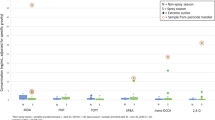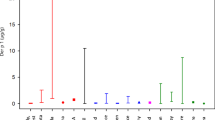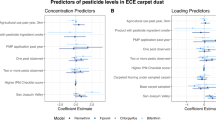Abstract
Organophosphate pesticides (OPs) are related to ill health among adults, including farmworkers who are exposed to OPs as part of their regular work. Children of both farmworkers and non-farmworkers in agricultural communities may also be affected by pesticide exposure. Study groups of 100 farmworkers with a referent child (aged 2–6 years) and 100 non-farmworkers with a referent child were recruited to participate in three data collection periods over the course of a year. At each collection, participants provided three urine samples within 5 days, and homes and vehicles were vacuumed to collect pesticide residues in dust. In thinning and harvest seasons, farmworkers and their children had higher dimethyl urinary metabolites than non-farmworkers and their children. During the non-spray season, the urinary metabolites levels decreased among farmworkers to a level comparable to that of non-farmworkers. Farmworkers consistently had higher pesticide residues in their home and vehicle dust. Differences exist between farmworkers and non-farmworkers in urinary metabolites, and the differences extended throughout the agricultural seasons.OP metabolites are seen at much higher levels for farmworkers and their children than for non-farmworkers and their children during agricultural seasons when OPs are in use. These metabolite levels were significantly higher than the nationwide NHANES IV survey and up to 10-fold higher than other rural agricultural studies.
This is a preview of subscription content, access via your institution
Access options
Subscribe to this journal
Receive 6 print issues and online access
$259.00 per year
only $43.17 per issue
Buy this article
- Purchase on Springer Link
- Instant access to full article PDF
Prices may be subject to local taxes which are calculated during checkout



Similar content being viewed by others
References
Barr DB, Bravo R, Weerasekera G, Caltabiano LM, Whitehead RD, Jr., Olsson AO et al. Concentrations of dialkyl phosphate metabolites of organophosphorus pesticides in the U.S. population. Environ Health Perspect 2004; 112: 186–200.
USEPA. Pesticide Industry Sales and Usage—2006 and 2007 Market Estimates. Office of Chemical Safety and Pollution Prevention, US Environmental Protection Agency (USEPA): Washington, DC. 2011.
USDA-NASS Data for Washington from the agricultural chemical use database, 2011 USDA-NASS, Washington, DC.
USEPA Azinphos-methyl Phase-out 2009. Available from http://www.regulations.gov/#!docketDetail;D=EPA-HQ-OPP-2005-0061.
USEPA Reregistration eligibility decision for chlorpyrifos. EPA 738-R-01-007; EPA: Washington, DC.
USEPA Interim reregistration eligibility document for diazinon. EPA 738-R-04-006. EPA: Washington, DC.
USEPA Interim reregistration eligibility document for azinphos-methyl. EPA: Washington, DC.
McCauley LA, Anger WK, Keifer M, Langley R, Robson MG, Rohlman D . Studying health outcomes in farmworker populations exposed to pesticides. Environ Health Perspect 2006; 114: 953–960.
Zahm SH, Blair A . Assessing the feasibility of epidemiologic research on migrant and seasonal farmworkers: an overview. Am J Ind Med 2001; 40: 487–489.
Zahm SH, Blair A, The Farmworker Epidemiology Research Group. Cancer feasibility studies among migrant farmworkers. Am J Ind Med 1997; 32: 301–302.
Kirkhorn SR, Schenker MB . Current health effects of agricultural work: respiratory disease, cancer, reproductive effects, musculoskeletal injuries, and pesticide-related illnesses. J Agric Saf Health 2002; 8: 199–214.
Mills PK, Yang R . Prostate cancer risk in California farm workers. J Occup Environ Med 2003; 45: 249–258.
Mills PK, Kwong S . Cancer incidence in the United Farmworkers of America (UFW), 1987–1997. Am J Ind Med 2001; 40: 596–603.
Beane Freeman LE, Bonner MR, Blair A, Hoppin JA, Sandler DP, Lubin JH et al. Cancer incidence among male pesticide applicators in the Agricultural Health Study cohort exposed to diazinon. Am J Epidemiol 2005; 162: 1070–1079.
Fritschi L, Benke G, Hughes AM, Kricker A, Turner J, Vajdic CM et al. Occupational exposure to pesticides and risk of non-Hodgkin's lymphoma. Am J Epidemiol 2005; 162: 849–857.
Colt JS, Stallones L, Cameron LL, Dosemeci M, Zahm SH . Proportionate mortality among US migrant and seasonal farmworkers in twenty-four states. Am J Ind Med 2001; 40: 604–611.
Andreotti G, Freeman LE, Hou L, Coble J, Rusiecki J, Hoppin JA et al. Agricultural pesticide use and pancreatic cancer risk in the Agricultural Health Study Cohort. Int J Cancer 2009; 124: 2495–2500.
Thompson B, Coronado GD, Grossman JE, Puschel K, Solomon CC, Islas I et al. Pesticide take-home pathway among children of agricultural workers: study design, methods, and baseline findings. J Occup Environ Med 2003; 45: 42–53.
Thompson B, Coronado GD, Vigoren EM, Griffith WC, Fenske RA, Kissel JC et al. Para ninos saludables: a community intervention trial to reduce organophosphate pesticide exposure in children of farmworkers. Environ Health Perspect 2008; 116: 687–694.
Coronado GD, Vigoren EM, Thompson B, Griffith WC, Faustman EM . Organophosphate pesticide exposure and work in pome fruit: evidence for the take-home pesticide pathway. Environ Health Perspect 2006; 114: 999–1006.
Quiros-Alcala L, Bradman A, Nishioka M, Harnly ME, Hubbard A, McKone TE et al. Pesticides in house dust from urban and farmworker households in California: an observational measurement study. Environ Health 2011; 10: 19 ahead of print 18 March 2011.
Lozier MJ, Curwin B, Nishioka MG, Sanderson W . Determinants of atrazine contamination in the homes of commercial pesticide applicators across time. J Occup Environ Hyg 2012; 9: 289–297.
Bradman A, Castorina R, Barr DB, Chevrier J, Harnly ME, Eisen EA et al. Determinants of organophosphorus pesticide urinary metabolite levels in young children living in an agricultural community. Int J Environ Res Public Health 2011; 8: 1061–1083.
Landrigan PJ, Goldman LR . Protecting children from pesticides and other toxic chemicals. J Expo Sci Environ Epidemiol 2011; 21: 119–120.
Moya J . Bearer CF, Etzel RA. Children's behavior and physiology and how it affects exposure to environmental contaminants. Pediatrics 2004; 113: 996–1006.
Fenske RA, Lu C, Barr D, Needham L . Children’s exposure to chlorpyrifos and parathion in an agricultural community in central Washington State. Environ Health Perspect 2002; 110: 549–553.
Rao P, Quandt SA, Doran AM, Snively BM, Arcury TA . Pesticides in the homes of farmworkers: Latino mothers' perceptions of risk to their children's health. Health Educ Behav 2006; 34: 335–353.
Lambert WE, Lasarev M, Muniz J, Scherer J, Rothlein J, Santana J et al. Variation in organophosphate pesticide metabolites in urine of children living in agricultural communities. Environ Health Perspect 2005; 113: 504–508.
Wessels D, Barr DB, Mendola P . Use of biomarkers to indicate exposure of children to organophosphate pesticides: Implications for a longitudinal study of children's environmental health. Environ Health Perspect 2003; 111: 1939–1946.
Daston G, Faustman E, Ginsberg G, Fenner-Crisp P, Ollin S, Sonawane B et al. A framework for assessing risks to children from exposure to environmental agents. Environ Health Perspect 2004; 112: 238–256.
Mills PK, Zahm SH . Organophosphate pesticide residues in urine of farmworkers and their children in Fresno County, California. Am J Ind Med 2001; 40: 571–577.
Gonzalez V, Huen K, Venkat S, Pratt K, Xiang P, Harley KG et al. Cholinesterase and paraoxonase (PON1) enzyme activities in Mexican-American mothers and children from an agricultural community. J Expo Sci Environ Epidemiol 2012; 22: 641–648.
Huen K, Harley K, Brooks J, Hubbard A, Bradman A, Eskenazi B et al. Developmental changes in PON1 enzyme activity in young children and effects of PON1 polymorphisms. Environ Health Perspect 2009; 117: 1632–1638.
Eskenazi B, Huen K, Marks A, Harley KG, Bradman A, Barr DB et al. PON1 and neurodevelopment in children from the CHAMACOS study exposed to organophosphate pesticides in utero. Environ Health Perspect 2010; 118: 1775–1781.
Furlong CE, Holland N, Richter RJ, Bradman A, Ho A, Eskenazi B . PON1 status of farmworker mothers and children as a predictor organophosphate sensitivity. Pharmacogenetics Genomics 2006; 16: 183–190.
Huen K, Bradman A, Harley K, Yousefi P, Boyd Barr D, Eskenazi B et al. Organophosphate pesticide levels in blood and urine of women and newborns living in an agricultural community. Environ Res 2012; 117: 8–16.
Thompson B, Coronado G, Puschel K, Allen E . Identifying constituents to participate in a project to control pesticide exposure in children of farmworkers. Environ Health Perspect 2001; 109: 443.
Coronado GD, Vigoren EM, Griffith WC, Faustman EM, Thompson B . Organophosphate pesticide exposure among pome and non-pome farmworkers: a subgroup analysis of a community randomized trial. J Occup Environ Med 2009; 51: 500–509.
American FactFinder Profile of General Population and Housing Characteristics: 2010 Demographic Profile Data 2010 March 22, 2013. Available from http://factfinder2.census.gov/faces/tableservices/jsf/pages.
Odetokun MS, Montesano MA, Weerasekera G, Whitehead RD, Jr, Needham LL, Barr DB . Quantification of dialkylphosphate metabolites of organophosphorus insecticides in human urine using 96-well plate sample preparation and high-performance liquid chromatography–electrospray ionization-tandem mass spectrometry. J Chromatogr B 2010; 878: 2567–2574.
Curl CL, Fenske RA, Kissel JC, Shirai JH, Moate TF, Griffith W et al. Evaluation of take-home organophosphorus pesticide exposure among agricultural workers and their children. Environ Health Perspect 2002; 110: A787–A792.
Westgard J Westgard Rules. 2012 [April 2, 2013]; Available from http://www.westgard.com/westgard-rules/.
Lehmann EL, D’Abrera HJM . Nonparametrics: Statistical Methods Based on Ranks. Holden-Day Inc: San Francisco, CA, USA. 1975.
Benjamini Y, Hochberg Y . Controlling the false discovery rate: a practical and powerful approach to multiple testing. J R Stat Soc Ser B (Methodological) 1995; 57: 289–300.
Castorina R, Bradman A, McKone TE, Barr DB, Harnly ME, Eskenazi B . Cumulative organophosphate pesticide exposure and risk assessment among pregnant women living in an agricultural community: a case study from the CHAMACOS cohort. Environ Health Perspect 2003; 111: 1640–1648.
Koch D, Lu C, Fisker-Andersen J, Jolley L, Fenske RA . Temporal association of children’s pesticide exposure and agricultural spraying: report of a longitudinal biological monitoring study. Environ Health Perspect 2002; 110: 829–833.
Griffith W, Curl CL, Fenske RA, Lu CA, Vigoren EM, Faustman EM . Organophosphate pesticide metabolite levels in pre-school children in an agricultural community: within- and between-child variability in a longitudinal study. Environ Res 2011; 111: 751–756.
Coronado GD, Holte S, Vigoren E, Griffith WC, Barr DB, Faustman E et al. Organophosphate pesticide exposure and residential proximity to nearby fields: evidence for the drift pathway. J Occup Environ Med 2011; 53: 884–891.
Centers for Disease Control NHANES 2003–2004 Laboratory Files 2003-2004 March 22, 2013. Available from www.cdc.gov/nchs/nhanes/nhanes2003-2004/lab03_04.htm.
McCauley LA, Beltran M, Phillips J, Lasarev M, Sticker D . The Oregon migrant farmworker community: an evolving model for participatory research. Environ Health Perspect 2001; 109: 449–455.
Lu C, Fenske RA, Simcox NJ, Kalman D . Pesticide exposure of children in an agricultural community: evidence of household proximity to farmland and take home exposure pathways. Environ Res 2000; 84: 290–302.
Lu C, Kedan G, Fisker-Andersen J, Kissel JC, Fenske RA . Multipathway organophosphorus pesticide exposures of preschool children living in agricultural and nonagricultural communities. Environ Res 2004; 96: 283–289.
National Children’s Study Improving the Health of America's Children2012 April 2, 2013. Available from https://www.nationalchildren'sstudy.gov/studylocations/Pages/default.aspx.
Acknowledgements
The research described in this article has been funded in part by the Environmental Protection Agency (Grant R826886) and the National Institute of Environmental Health Sciences (Grant P01 ES09601), but it has not been subjected to either agency’s required peer and policy review. The article does not necessarily reflect the views of either agency, and no official endorsement should be inferred. We acknowledge the contribution of members of our Community Advisory Board in designing and carrying out this project. We acknowledge the contribution of our field staff in collecting the many samples required for this project.
Author information
Authors and Affiliations
Corresponding author
Ethics declarations
Competing interests
The authors declare no conflict of interest.
Rights and permissions
About this article
Cite this article
Thompson, B., Griffith, W., Barr, D. et al. Variability in the take-home pathway: Farmworkers and non-farmworkers and their children. J Expo Sci Environ Epidemiol 24, 522–531 (2014). https://doi.org/10.1038/jes.2014.12
Received:
Accepted:
Published:
Issue Date:
DOI: https://doi.org/10.1038/jes.2014.12
Keywords
This article is cited by
-
Evaluation of the relationship between residential orchard density and dimethyl organophosphate pesticide residues in house dust
Journal of Exposure Science & Environmental Epidemiology (2019)
-
Application of improved approach to evaluate a community intervention to reduce exposure of young children living in farmworker households to organophosphate pesticides
Journal of Exposure Science & Environmental Epidemiology (2019)
-
A Pilot Study Evaluating Organochlorine and Organophosphate Pesticide Exposure in Children and Adolescents of Mexican Descent Residing in Hidalgo County, Texas
Journal of Immigrant and Minority Health (2019)
-
Acetylcholinesterase activity and time after a peak pesticide-use period among Ecuadorian children
International Archives of Occupational and Environmental Health (2018)
-
Seasonal and occupational trends of five organophosphate pesticides in house dust
Journal of Exposure Science & Environmental Epidemiology (2017)



